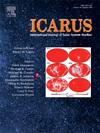Peculiar rainbows in Saturn’s E ring: Uncovering luminous bands near Enceladus
IF 2.5
2区 物理与天体物理
Q2 ASTRONOMY & ASTROPHYSICS
引用次数: 0
Abstract
We report observations of stripe-like features in Enceladus’ plumes captured simultaneously by Cassini’s VIMS-IR and ISS NAC instruments during flyby E17, with similar patterns seen in VIMS-IR data from flyby E13 and E19. These parallel stripes, inclined at approximately 16°to the ecliptic and 43°to Saturn’s ring plane, appear continuous across images when projected in the J2000 frame. A bright stripe, most visible at wavelengths around , acts as the zeroth-order diffraction peak of a reflection grating with an estimated groove spacing of 0.12–2.60 mm, while adjacent stripes are attributed to higher-order diffraction peaks. We suggest that this light-dispersing phenomenon originates from an inclined periodic structure within Saturn’s E ring. This structure, constrained between Saturn’s G ring and Rhea’s orbit, likely consists of fresh ice particles supplied by Enceladus’ plumes.
土星E环上奇特的彩虹:揭示土卫二附近的发光带
我们报告了卡西尼号的VIMS-IR和ISS的NAC仪器在飞越E17期间同时捕捉到的土卫二羽流的条纹状特征,在飞越E13和E19的VIMS-IR数据中也看到了类似的模式。这些平行的条纹,与黄道倾斜约16°,与土星环平面倾斜约43°,当在J2000的框架中投射时,在图像上看起来是连续的。在波长约为5μm时最明显的明亮条纹是反射光栅的零级衍射峰,其槽间距估计为0.12-2.60 mm,而相邻条纹则属于高阶衍射峰。我们认为这种光散射现象源于土星E环内的倾斜周期结构。这个结构被限制在土星的G环和土卫五的轨道之间,很可能是由土卫二的羽流提供的新鲜冰粒组成的。
本文章由计算机程序翻译,如有差异,请以英文原文为准。
求助全文
约1分钟内获得全文
求助全文
来源期刊

Icarus
地学天文-天文与天体物理
CiteScore
6.30
自引率
18.80%
发文量
356
审稿时长
2-4 weeks
期刊介绍:
Icarus is devoted to the publication of original contributions in the field of Solar System studies. Manuscripts reporting the results of new research - observational, experimental, or theoretical - concerning the astronomy, geology, meteorology, physics, chemistry, biology, and other scientific aspects of our Solar System or extrasolar systems are welcome. The journal generally does not publish papers devoted exclusively to the Sun, the Earth, celestial mechanics, meteoritics, or astrophysics. Icarus does not publish papers that provide "improved" versions of Bode''s law, or other numerical relations, without a sound physical basis. Icarus does not publish meeting announcements or general notices. Reviews, historical papers, and manuscripts describing spacecraft instrumentation may be considered, but only with prior approval of the editor. An entire issue of the journal is occasionally devoted to a single subject, usually arising from a conference on the same topic. The language of publication is English. American or British usage is accepted, but not a mixture of these.
 求助内容:
求助内容: 应助结果提醒方式:
应助结果提醒方式:


